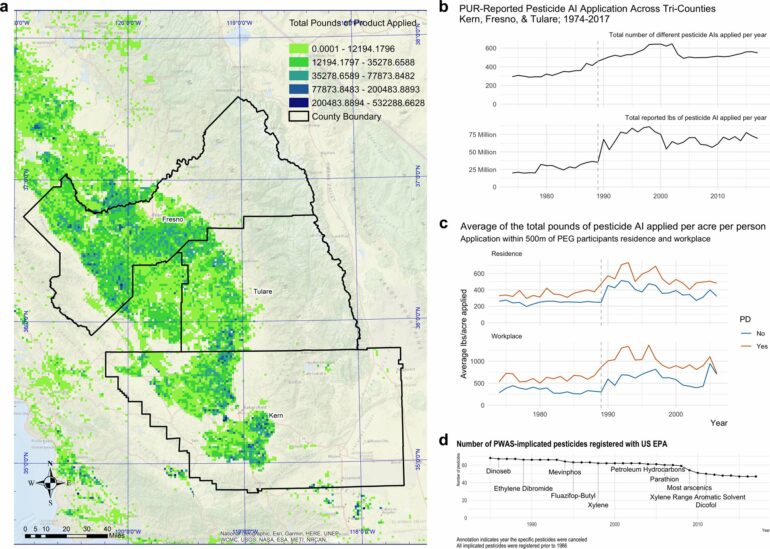Researchers at UCLA Health and Harvard have identified 10 pesticides that significantly damaged neurons implicated in the development of Parkinson’s disease, providing new clues about environmental toxins’ role in the disease.
While environmental factors such as pesticide exposure have long been linked to Parkinson’s, it has been harder to pinpoint which pesticides may raise risk for the neurodegenerative disorder. Just in California, the nation’s largest agricultural producer and exporter, there are nearly 14,000 pesticide products with over 1,000 active ingredients registered for use.
Through a novel pairing of epidemiology and toxicity screening that leveraged California’s extensive pesticide use database, UCLA and Harvard researchers were able to identify 10 pesticides that were directly toxic to dopaminergic neurons. The neurons play a key role in voluntary movement, and the death of these neurons is a hallmark of Parkinson’s.
Further, the researchers found that co-exposure of pesticides that are typically used in combinations in cotton farming were more toxic than any single pesticide in that group.
For this study, published May 16 in Nature Communications, UCLA researchers examined exposure history going back decades for 288 pesticides among Central Valley patients with Parkinson’s disease who had participated in previous studies.
The researchers were able to determine long-term exposure for each person and then, using what they labeled a pesticide-wide association analysis, tested each pesticide individually for association with Parkinson’s. From this untargeted screen, researchers identified 53 pesticides that appeared to be implicated in Parkinson’s—most of which had not been previously studied for a potential link and are still in use.
Those results were shared for lab analysis led by Richard Krolewski, MD, Ph.D., an instructor of neurology at Harvard and neurologist at Brigham and Women’s Hospital. He tested the toxicity for most of those pesticides in dopaminergic neurons that had been derived from Parkinson’s patients through what’s known as induced pluripotent stem cells, which are a type of “blank slate” cell that can be reprogrammed into neurons that closely resemble those lost in Parkinson’s disease.
The 10 pesticides identified as directly toxic to these neurons included: four insecticides (dicofol, endosulfan, naled, propargite), three herbicides (diquat, endothall, trifluralin), and three fungicides (copper sulfate [basic and pentahydrate] and folpet). Most of the pesticides are still in use today in the United States.
Aside from their toxicity in dopaminergic neurons, there is little that unifies these pesticides. They have a range of use types, are structurally distinct, and do not share a prior toxicity classification.
Researchers also tested the toxicity of multiple pesticides that are commonly applied in cotton fields around the same time, according to California’s pesticide database. Combinations involving trifluralin, one of the most commonly used herbicides in California, produced the most toxicity. Previous research in the Agricultural Health Study, a large research project involving pesticide applicators, had also implicated trifluralin in Parkinson’s.
Kimberly Paul, Ph.D., a lead author and assistant professor of neurology at UCLA, said the study demonstrated their approach could broadly screen for pesticides implicated in Parkinson’s and better understand the strength of these associations.
“We were able to implicate individual agents more than any other study has before, and it was done in a completely agnostic manner,” Paul said. “When you bring together this type of agnostic screening with a field-to-bench paradigm, you can pinpoint pesticides that look like they’re quite important in the disease.”
The researchers are next planning to study epigenetic and metabolomic features related to exposure using integrative omics to help describe which biologic pathways are disrupted among Parkinson’s patients who experienced pesticide exposure. More detailed mechanistic studies of the specific neuronal processes impacted by pesticides such as trifluralin and copper are also underway at the Harvard/Brigham and Women’s labs.
The lab work is focused on distinct effects on dopamine neurons and cortical neurons, which are important for the movement and cognitive symptoms in Parkinson’s patients, respectively. The basic science is also expanding to studies of pesticides on non-neuronal cells in the brain—the glia—to better understand how pesticides influence the function of these critical cells.
More information:
Kimberly C. Paul et al, A pesticide and iPSC dopaminergic neuron screen identifies and classifies Parkinson-relevant pesticides, Nature Communications (2023). DOI: 10.1038/s41467-023-38215-z
Provided by
University of California, Los Angeles
Citation:
Researchers identify 10 pesticides toxic to neurons involved in Parkinson’s (2023, May 17)



